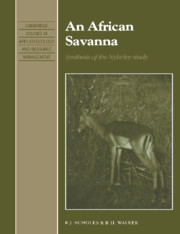Book contents
- Frontmatter
- Contents
- Preface
- I Nylsvley in an African savanna context
- II The key determinants: water, nutrients, fire and herbivory
- III The carbon cycle
- IV Community and landscape pattern and change
- 12 Rich savanna, poor savanna
- 13 Community structure, composition and dynamics
- 14 Tree–grass interactions
- 15 Plant–herbivore interactions
- Part V Lessons from Nylsvley
- Bibliography
- Index
13 - Community structure, composition and dynamics
Published online by Cambridge University Press: 06 October 2009
- Frontmatter
- Contents
- Preface
- I Nylsvley in an African savanna context
- II The key determinants: water, nutrients, fire and herbivory
- III The carbon cycle
- IV Community and landscape pattern and change
- 12 Rich savanna, poor savanna
- 13 Community structure, composition and dynamics
- 14 Tree–grass interactions
- 15 Plant–herbivore interactions
- Part V Lessons from Nylsvley
- Bibliography
- Index
Summary
An important lesson learned during the IBP era was that it is not possible to predict all the workings of an ecosystem on the basis of fluxes of material and energy alone. In many crucially important processes, the exchanges of energy and matter are inconsequential: for instance, in the process of pollination. The sensitive techniques of population dynamics and community ecology provide an essential complement to the blunt but powerful instruments of systems ecology.
Community-level studies occurred in two separate phases during the Nylsvley project. Early in the programme, several studies aimed to identify the major communities, and associate them with environmental factors. Ben Coetzee, Roy Lubke, Gillaume Theron and Robert Whittaker made important contributions to this phase. A decade later, Peter and Sue Frost, Dick Yeaton and Graham von Maltitz revived interest in community and population dynamics with a series of manipulative experiments.
Patterns of species distribution
The phytosociological survey of the study site had suggested that the broad-leafed savanna of the study site, named the Eragrostis pallens– Burkea Africana tree savanna, was not homogeneous. It included two levels of community organisation (Coetzee et al. 1976). However, three detailed quantitative studies failed to identify species groupings which were sufficiently consistent to justify treating them as a community (Lubke et al. 1976, 1983; Whittaker et al. 1984; Theron et al. 1984). These studies were carried out in transects of contiguous quadrats, 300–1000 metres long, and located in the mid–slope area of the broad-leafed savanna.
- Type
- Chapter
- Information
- An African SavannaSynthesis of the Nylsvley Study, pp. 208 - 214Publisher: Cambridge University PressPrint publication year: 1993



